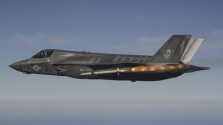Declaration: This work was in part funded in part by U.S. Air Force (USAF) (FA2386-16-14036), U.S. Office of Naval Research Global (ONRG) (N62909-18-1-2013), and Australian Research Council Discovery Project (DP-200101893).
Hero image: PhD candidate Ziqian Zhang and Professor Benjamin Eggleton with a drone they used in an experiment to demonstrate the high-resolution radar imaging.
guess the US will start fielding photonic radars, how fast can they do it?
University of Sydney scientists have achieved a technology breakthrough with potentially life-saving applications - all using an improved version of radar.
Traditionally, radar is associated with airport control towers or military fighter jets, but a new, highly sensitive radar developed at the University of Sydney takes this technology into the human range.
Called ‘advanced photonic radar’, the ultra-high-resolution device is so sensitive it can detect an object’s location, speed, and/or angle in millimetres as opposed to metres. This could enable usage in hospitals to monitor people’s vital signs such as breathing and heart rate.
In the case of breathing, the radar could continuously detect a person’s chest rising and falling. The usual method of monitoring this is via a strap around a person’s chest. In the case of burn victims with sensitive skin, however, this is impractical. Similarly, infants have insufficient attaching areas for sleep apnea monitoring, so the novel radar technology could be a better alternative.
Privacy is another concern addressed by the new system. Traditional health surveillance methods such as cameras capture a patient’s face, whereas radar, which uses only radio waves, allows patients to remain completely anonymous.


